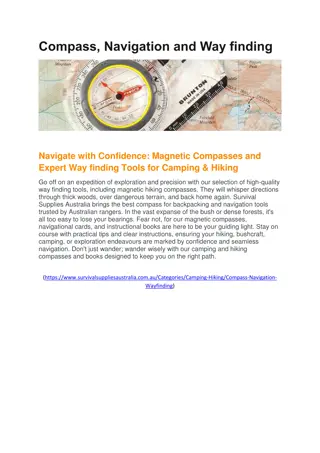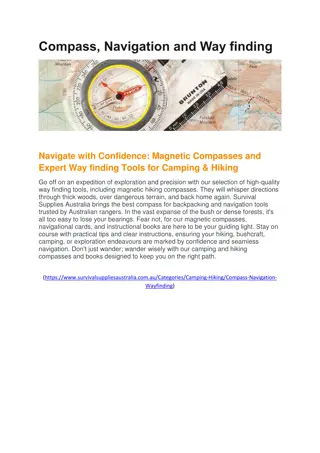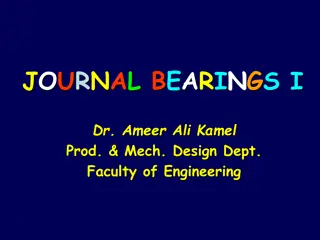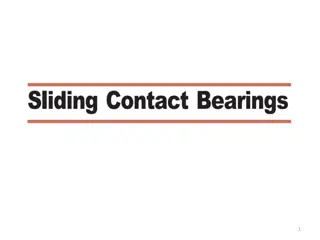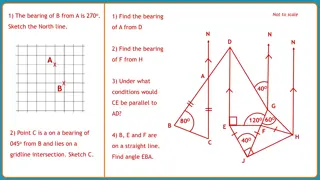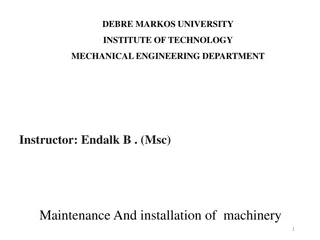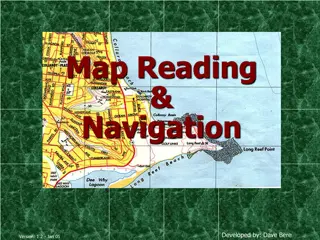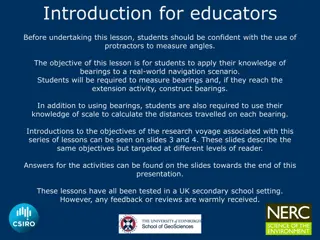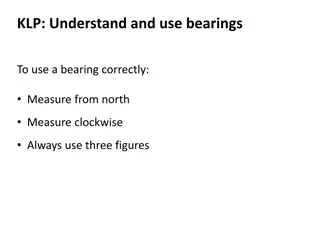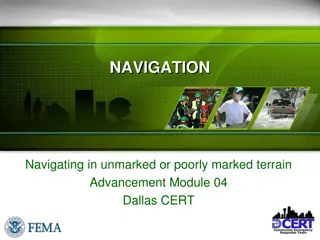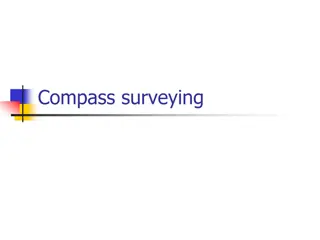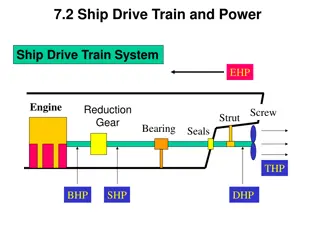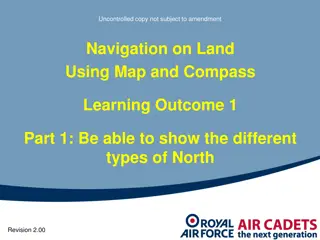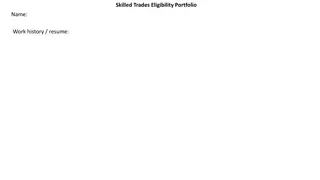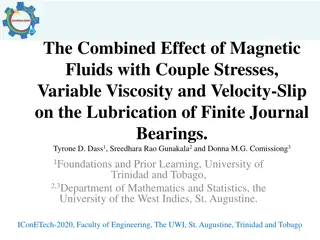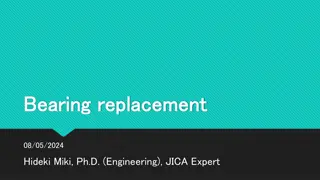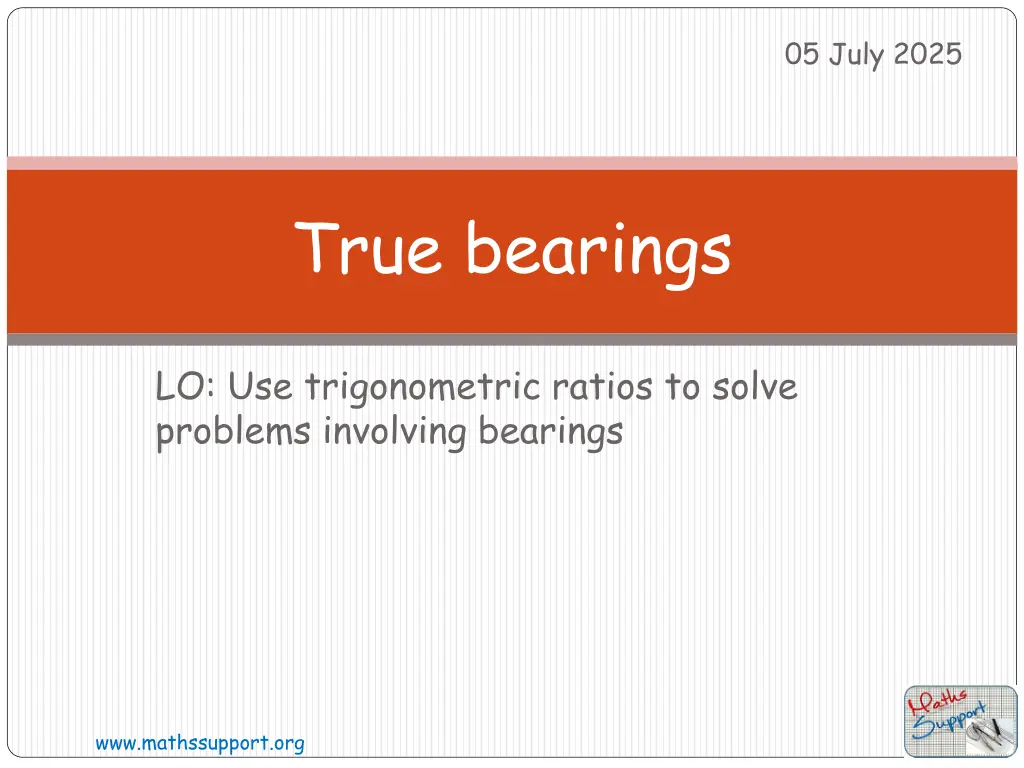
Understanding Bearings and Compass Points
Explore how to use trigonometric ratios and compass points to solve problems involving bearings, with explanations and examples provided in this detailed guide. Learn about measuring direction, back bearings, and calculating distances and bearings between points.
Download Presentation

Please find below an Image/Link to download the presentation.
The content on the website is provided AS IS for your information and personal use only. It may not be sold, licensed, or shared on other websites without obtaining consent from the author. If you encounter any issues during the download, it is possible that the publisher has removed the file from their server.
You are allowed to download the files provided on this website for personal or commercial use, subject to the condition that they are used lawfully. All files are the property of their respective owners.
The content on the website is provided AS IS for your information and personal use only. It may not be sold, licensed, or shared on other websites without obtaining consent from the author.
E N D
Presentation Transcript
05 July 2025 True bearings LO: Use trigonometric ratios to solve problems involving bearings www.mathssupport.org
Compass points 45 between North and east 45 between north and west N NW NE E W SW SE 45 between south and east 45 between south and west S www.mathssupport.org
Compass points When using Compass points for direction, you will see notation such as. N 35 E N 35 E N Which means 35 east of North 35 E W S www.mathssupport.org
Compass points When using Compass points for direction, you will see notation such as. W 25 S N Which means 25 south of west E W 25 W 25 S S www.mathssupport.org
Bearings Bearings are a measure of direction taken from North. If you were travelling North you would be travelling on a bearing of 000 . If you were travelling from the point P in the direction shown by the arrow then you would be travelling on a bearing of 000 . bearing of 075 . If you were travelling from the point P in the direction shown by the arrow then you would be travelling on a N Bearings are always measured clockwise from North and are written as three figures. 75 P www.mathssupport.org
Bearings The bearing from point A to point B is 105 . What is the bearing from point B to point A? N The angle from B to A is 105 + 180 = 285 N 105 A This is called a back bearing. ? 105 B 180 www.mathssupport.org
Bearings An airplane departs from A and flies on a 138o course for 342 km. It then changes direction to a 228o course and flies a further 482 km to town C. (a) Find the distance of C from A. (b) Find the bearing of C from A. Sketch a fully labelled diagram N With this information we can calculate the angle ABC The airplane turns 228 138 angle ABC = 90 138 A = 90 N B 591km We use Pythagoras theorem to Find AC 228 AC2 = AB2 + BC2 = 3422 + 4822 AC = 591 km C www.mathssupport.org
Bearings An airplane departs from A and flies on a 138o course for 342 km. It then changes direction to a 228o course and flies a further 485 km to town C. (a) Find the distance of C from A. (b) Find the bearing of C from A. Sketch a diagram To find the bearing of C from A we need the angle measured from the north to the line AC. To find this angle we need the angle BAC named tan-1 = 342 54.8o The required angle is The bearing of C from A is about 192.8. N 138 A N B 485 591km Find 228 138 + 54.8 192.8 C www.mathssupport.org
Bearings A rally driver travels on a bearing of 145 for 2.85 km. How far east of the starting position is the rally driver? Sketch a diagram N 145 You need to find the distance east the driver is , the length AB. This form a right angled triangle We know the angle inside the triangle at A xkm B Start A 55 x Find AB cos 55o= 2.85 km 2.85 x = 2.85 cos 55o finish C 1.63 x The driver is about 1.63 km east of his starting point www.mathssupport.org
Bearings A small airplane depart city A and flies on a 143 course for 368 km landing at B. After delivered cargo, it departs on a 233 course and flies a further 472 km to city C. Find: (a) the distance of C from A (b) the bearing of C from A You ll find the distance between A and C. Sketch a diagram N 143 Find the angle ? ?? co-interior angles Find the angle ? ?? 180 - 143 = 37 angles at a point A 360 -37 -233 = 90 N Using Pythagoras theorem x2 = 3682 + 4722 37 B x = 3682+ 4722 x 598.5 km 233 C So, C is about 598.5 km from A. www.mathssupport.org
Bearings A small airplane depart city A and flies on a 143 course for 368 km landing at B. After delivered cargo, it departs on a 233 course and flies a further 472 km to city C. Find: (a) the distance of C from A (b) the bearing of C from A To find the bearing of C from A we need the angle ? ?? ( ). A 143 To find the angle ? ?? we will use tangent tan = Sketch a diagram N opposite adjacent 472 368 N 37 tan = B 233 472 368 52.1 =tan 1 The bearing of C from A is 143 + 52.1 195 C www.mathssupport.org
Thank you for using resources from A close up of a cage Description automatically generated For more resources visit our website https://www.mathssupport.org If you have a special request, drop us an email info@mathssupport.org Get 20% off in your next purchase from our website, just use this code when checkout: MSUPPORT_20 www.mathssupport.org


